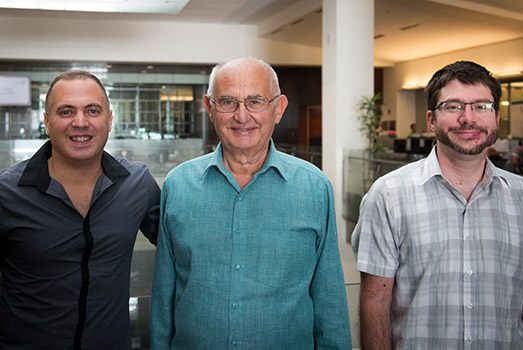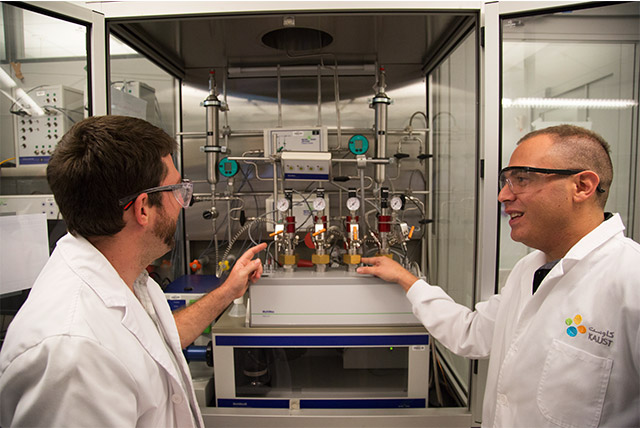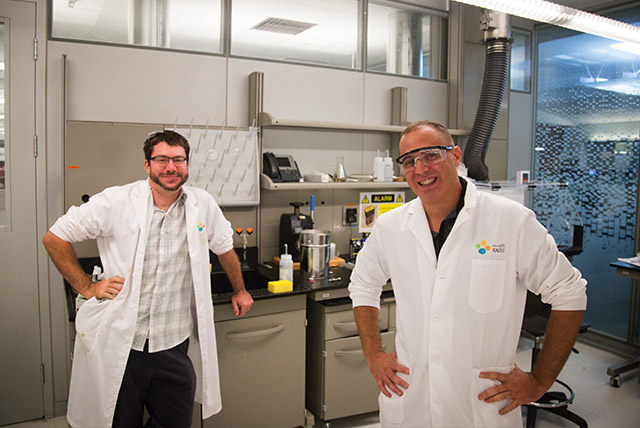Novel carbon capture technique offers hope for sustainable energy future

From The left, Dr. Valerio D' Elia (Research Scientist), Prof. Jean Marie Basset (Director of KCC) and Dr. Jeremie Pelletier (KCC laboratory manager), taken at KCC laboratories.
It’s now a generally accepted fact that the ever growing levels of carbon dioxide (CO2) in the Earth’s atmosphere, as a result of fossil fuel combustion to generate energy, poses significant challenges to the planet. The effects can be seen for instance in the ongoing ocean acidification that is seriously treathening the marine ecosystems and in the shrinking of the polar ice caps caused by the “heat-trapping” from greenhouse gases emitted through human activities since the beginning of the industrial era.
While CO2 is naturally present in our atmosphere, as part of the Earth's life-sustaining carbon cycle, as it’s absorbed from the air by plants in photosynthesis, there’s about 30% more carbon dioxide (CO2) in the air today than there was less than two centuries ago.
In a recent paper published jointly by scientists from the KAUST Catalysis Center (KCC) and Technische Universität München (TU Munich) it is stated that “the atmospheric concentration of CO2 is now set to surpass the symbolic mark of 400 ppm (parts-per-million) with a growth rate of over 2 ppm per year.” They also report that only about 0.5% of the CO2 emitted is currently exploited as renewables for the production of useful chemicals.
Towards a Sustainable Solution for CO2 Conversion

Dr. Valerio D' Elia and Dr. Jeremie Pelletier working with the "in situ" infrared autoclaves
A co-author of the paper, research scientist Dr. Valerio D'Elia from KCC, who also works with KCC Director Prof. Jean-Marie Basset in managing the collaboration with TU Munich, describes the concept of converting CO2 directly from flue gas as “a dream reaction.” There is a great value in using a catalytic system to convert CO 2 into useful chemicals as it comes out.
While catalysts are often seen as viable green technology options to increase the renewable rates of CO2, many of these catalytic processes rely on the use of increasingly rare and costly metals such as rhodium, iridium and platinum. The other challenge is that the reaction that involve CO 2 are generally highly energy-intensive thus offsetting the environmental benefits of the CO2 fixed into the chemicals produced. As Dr. D’Elia further explains:
“CO2 is a very thermodynamically stable molecule. The basic problem in order to recycle CO2 is that, first of all and very often, you have to purify it and compress it. It’s not possible to use CO2 from the air, or from a fume stacks, simply like that because it’s full of impurities, moisture and too less concentrated. Then it often becomes necessary to warm up the CO2, at 300 to 400 degrees, for the purposes of converting it into useful chemicals.
So, in the end, you will always produce more CO2 than the CO2 that you’ve transformed. That’s the problem with CO2. Basically everything you do has a cost. The energy that we use is powered by the combustion of oil -- which in turn produces more CO2.”
Therefore, the real feasibility test is to find an actually sustainable chemistry solution.
In this light, the significant breakthrough offered by the KCC-TU Munich research team is that, through spectroscopic and mechanistic procedures, they have been able to identify and study an abundantly available metallic catalyst capable of converting CO2 at room temperature and atmospheric pressure.
Focusing on the reaction between epoxides and CO2 to form cyclic carbonates, through a combination of in situ infrared IR and nuclear magnetic resonance (NMR) spectroscopic techniques and kinetic studies. “We are able to transform directly from a very low concentration of CO2 using a very simple catalyst,” said D’Elia. “This is the plus point. I look forward to a future where people will use this method make CO2 directly from the fume stacks, make useful products, and absorb CO2 at the same time.”
Managing CO2 Emissions for the Future

Dr Jeremie Pelletier (left) and Dr. Valerio D' Elia (right), taken at KCC laboratories.
Since our current technological landscape doesn’t permit us to fully, or even significantly, replace fossil fuels for vital energy generation requirements through renewable sources like solar and wind energy, it’s imperative to find solutions to deal with the inevitably continuing problem of CO2 emissions.
Certain governmental authorities around the world have enforced carbon capture and storage (CCS) regulations as a solution. Also known as CO2 capture and sequestration, Dr. D’Elia describes this process as basically capturing the CO2, by stripping it from the stream and using some amine to bind the CO2, warming it up and then releasing the CO2 to compress it in a cylinder or pumping it underground,. The adoption of this practice has been met with resistance and eventually abandoned in Germany. They believe instead that the only feasible path to follow is through direct capture and utilization and the increased use of renewable energy.
The carbon capture and utilization (CCU) paradigm advances the view that CO2 is a valuable source of carbon that can be utilized in the production of useful chemicals for which there is actual or potential demand. Along this line of argument, D’Elia describes the research he and his colleagues recently published as precisely such a feasible carbon capture and utilization technique – which achieves the capture in a millisecond as the CO 2 is directly transformed into an hemicarbonate and converted,Thereby eliminating the need to purify it or store it in an underground reservoir.
Possible Impacts for Saudi Arabia
While Saudi Arabia doesn’t currently have established regulations for CO2 emissions, companies in the energy sector worldwide are interested in finding ways of utilizing CO2 instead of paying carbon taxes and adding to the global warming problem. Companies in the Kingdom, burn a lot of fossil fuels and have a vested interest in recovering and converting the spent carbon. “So it’s not only recovering the CO2 but also using the carbon as a C1 block basically,” said Valerio D’Elia. The research he and his colleagues have published, using sustainable catalysts to convert CO 2 offers the possibility, as he further describes below, to contribute to the knowledge economy and diversification of the Kingdom:
“These economically viable minerals which are at the basis of these sustainable catalysts are very abundant in Saudi Arabia. So this would be a very good opportunity for the Kingdom to develop this kind of chemistry in the view of transitioning from a CO2 producing country to a leader in the absorption and reuse of large amounts of CO2 into make other chemicals.”
Related Links:
- Dynamics of the NbCl5-Catalyzed Cycloaddition of Propylene Oxide and CO2: Assessing the Dual Role of the Nucleophilic Co-Catalysts. Chemistry - A European Journal, Volume 20, Issue 37, pages 11870–11882, September 8, 2014.
- KAUST Catalysis Center
- TU Munich Catalysis Research Center (CRC)
By Meres J. Weche, KAUST News

